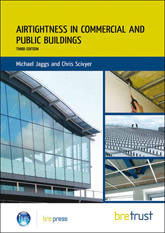
Airtightness in commercial and public buildings Downloadable Version
This guide is aimed at designers, project managers and specialist contractors involved in the construction of commercial and public buildings. It sets out the principles of providing effective airtightness within new buildings, through the design process and identifies common areas where particular attention is needed during construction. The design section includes generic examples of airtightness critical detailing and provides advice on avoiding leakage paths. The guidance also covers managing the airtightness process from design through construction and airtightness compliance testing to handover. This third edition has been revised to include experience gained since the introduction of the requirements for airtightness testing within Building Regulations (England and Wales) Approved Document L2A 2006 and 2010.
Contents
Glossary and Preface
Introduction
1 Background principles
- Understanding the causes of infiltration (Air infiltration. The effect of wind. The effect of air buoyancy)
- Ventilating without infiltration
- The benefits of minimising infiltration (Energy and cost savings. Reduced CO2 emissions. Space heating (air-conditioning) systems. Control systems and heat recovery. Climate responsive design. Comfort. Reduced risk of deterioration. Heating capacity)
- Infiltration paths (Climate responsive design. Comfort. Reduced risk of deterioration)
2 Design principles
- Identifying zones requiring protection (Limits of the conditioned zone. Entrances)
- Designing an airtight envelope (Overview. Choosing materials for infiltration control. Sealants. Site-applied expanding foam sealants. Gaskets. Draughtstripping. Mineral wool. Preformed flexible jointing strips. Membranes: primarily polyethylene film or sheet. EPDM. Breather membranes. Provide explicit detailing. Designing access to the airtightness layer. Selection of components. Implications of air barrier location)
Specification
3 Achieving airtightness
- Inspection during construction (Sitework stage: designer’s duties. Sitework stage: contractors’ duties)
- Testing and auditing for airtightness (Airtightness testing. Air leakage audits. Ventilation studies. Component testing)
Appendices
- Ventilation requirements. (Fresh air requirements. Indoor pollution. Ventilation to remove products of internal activities. Natural ventilation. Mechanical ventilation. Actual ventilation with building in operation)
- Guidance notes for site inspections (Common inspection locations. Key inspection points for the four main construction types)
References and further reading
Useful addresses
